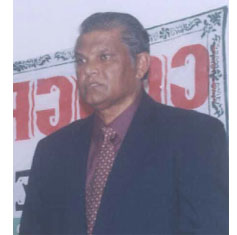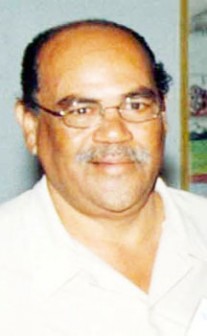Differences of opinion have surfaced between the Guyana Geology and Mines Commission (GGMC) and the Guyana Gold and Diamond Miners Association (GGDMA) following last week’s expression of concern by GGMC Chairman Major General (rtd) Joe Singh over the difference between gold production targets and declarations to the Guyana Gold Board.
At the GGDMA’s bi-monthly meeting on Wednesday May 4, Singh reportedly said that gold declarations should be higher and alluded to stories of “a lucrative cross-border movement of gold.” However, in a telephone interview with this newspaper earlier this week, GGDMA Executive Secretary Edward Shields said that while it is true that gold declaration continues to fall below production there are “several other likely reasons for this outside of smuggling.”

Shields explained that gold can only to deemed to be smuggled “if it leaves the jurisdiction,” and, he added, “the fact is that large quantities of gold are actually changing hands inside Guyana.” Shields told Stabroek Business that while he does not challenge the view that some of gold that cannot be accounted for by way of declarations to the Gold Board is being smuggled, the amount of gold which is being utilized for various business purposes inside Guyana might surprise the authorities.
Shields explained that the current continually rising price of gold has meant that it has become the ideal store of value for speculators who can afford to buy and hold gold. “It would not surprise me, for example, if gold is found in safe deposit boxes and other safe places where it is simply being held for speculative purposes,” Shields said. The GGDMA official rushed to the defence of small miners pointing out that “those speculative practices do not apply to small miners. Small miners need to exchange their gold for cash in order to attend to their families’ needs and keep their businesses turning over. Speculation is practiced by wealthy people.”
Several months ago, Shields had told Stabroek Business that rising gold prices had drawn several urban business houses – not traditionally known to be involved in the industry – into gold. Last week, Shields told Stabroek Business that it was now no secret that some of those urban businesses have invested “in one way or another” in the gold industry. “Without wishing to mention names we are aware that there are doctors and lawyers and people in other conventional fields who are now involved in the gold industry,” he said. “These are not traditional miners and I believe that they will run from the industry at the first sign that the fortunes of gold have changed. In the meantime, however, the practice of buying and selling gold right here in Guyana is as profitable a business as you can become involved in.”

A business source who agreed to speak with Stabroek Business on condition of anonymity confirmed that conventional urban businessmen were indeed paying a “close interest” in gold as what he described as “a significant business opportunity”. The source said that it was “more than likely” that some businesses in “the trading and other sectors” had “extended their interests to include gold”. He said that as far as he was aware there was nothing wrong with any shrewd businessman “getting into a line of business that is obviously more profitable than conventional trading”.
While official reports indicate the gold declaration for 2011 so far stands at around 106,000 ounces, Shields said he believes that production could climb as high as 420,000 ounces this year. Asked about the difference between gold mined and gold declared to the Guyana Gold Board Shields said his own guess would be that the difference is around 35 per cent. “That figure, however, cannot all be attributed to what can properly described as smuggling, since the culture associated with the use of gold means that we cannot honestly tell how much of it is smuggled and how much of it is bought and sold right here in Guyana.”
Asked whether he felt a shortfall in gold declaration as high as 35 per cent could be attributed to the mineral being used for speculative purposes the source said while he was not in a position to provide a “yes or no comment,” he believed the volume of gold being acquired by local businessmen “could be higher than people think”. The source said it had to be borne in mind that apart from buying gold from other sources “some businessmen actually had direct investments in the industry, some of it through funding small operations and what this obviously means is that they have direct access to gold.”
According to Shields, assessments of the extent to which the smuggling of gold takes place must also take account of the practice of large financiers, including Brazilian businesses, who provide funding for gold operations and secure their repayment in gold. “Those who know the mining industry would be aware that several Brazilian operations deal in gold rather than local currency. Their Brazilian workers get paid in gold. It’s a different situation with local small miners and workers. They have family and business obligations here in Guyana. The Brazilians have obligations to their families in Brazil and therefore their need for local currency is limited.”
Shields told Stabroek Business that the internal trade in gold that circumvents to local declaratory mechanisms can also be accounted for through the dynamics of the gold industry. “What fluctuating prices mean is that many jewellers are no longer holding gold since many customers are not prepared to pay jewellery prices that take account of rising gold prices. What the jewellers are saying to customers is that they must bring their own gold. Some jewellers are charging up to—in workmanship charges—$3,500 for every pennyweight of gold jewellery made.” And according to Shields since the use of gold as a store of value applies to jewellery as much as it applies to raw gold, as there is also a high local demand for gold for jewellery purchases “People needing jewellery are diverting a lot of gold to jewellers, “ Shields says.
The GGDMA Executive Director says he believes that record high world market prices for gold coupled with high local prices has meant that there is less of an incentive to smuggle gold. He explained that miners and traders can acquire good prices for gold at the Gold Board. “And even outside the Gold Board it is known that you can get $10,000 or perhaps $15,000 an ounce more.” Shields added.





